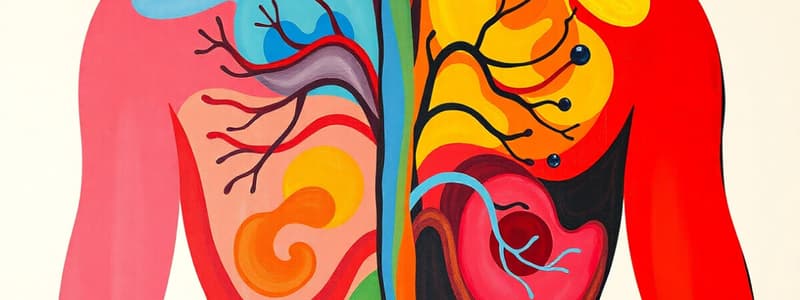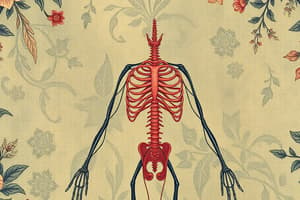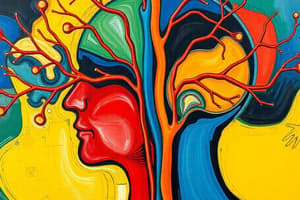Podcast
Questions and Answers
What is the primary function of peripheral chemoreceptors?
What is the primary function of peripheral chemoreceptors?
- Regulate oxygen levels in the lungs
- Control heart rate
- Induce contraction of respiratory muscles
- Monitor the levels of oxygen, carbon dioxide, and pH in arterial blood (correct)
Which of the following is a characteristic of restrictive lung disorders?
Which of the following is a characteristic of restrictive lung disorders?
- Difficulty exhaling air
- Narrowing of the airways
- Increased airway resistance
- Decreased lung volume and capacity (correct)
Which organ is NOT part of the digestive tract?
Which organ is NOT part of the digestive tract?
- Rectum
- Esophagus
- Liver (correct)
- Stomach
What does segmentation refer to in the context of digestion?
What does segmentation refer to in the context of digestion?
Which organ follows the pharynx in the digestive tract?
Which organ follows the pharynx in the digestive tract?
Ingestion is best defined as which of the following?
Ingestion is best defined as which of the following?
What role do accessory organs play in digestion?
What role do accessory organs play in digestion?
Which process involves the breakdown of food into smaller molecules?
Which process involves the breakdown of food into smaller molecules?
What is the primary function of the glomerulus in urine production?
What is the primary function of the glomerulus in urine production?
Which process primarily occurs in the renal tubule where useful substances are returned to the blood?
Which process primarily occurs in the renal tubule where useful substances are returned to the blood?
What is the formula for calculating Net Filtration Pressure (NFP)?
What is the formula for calculating Net Filtration Pressure (NFP)?
How does the myogenic mechanism respond to increased blood pressure?
How does the myogenic mechanism respond to increased blood pressure?
What role do macula densa cells play in the tubuloglomerular feedback mechanism?
What role do macula densa cells play in the tubuloglomerular feedback mechanism?
How does the RAAS system affect blood pressure and GFR?
How does the RAAS system affect blood pressure and GFR?
What is the main effect of aldosterone on urine composition?
What is the main effect of aldosterone on urine composition?
What effect does ADH have on the kidneys?
What effect does ADH have on the kidneys?
What is the primary function of the cardiac conduction system in the heart?
What is the primary function of the cardiac conduction system in the heart?
Which wave in an electrocardiogram (ECG) represents atrial depolarization?
Which wave in an electrocardiogram (ECG) represents atrial depolarization?
What is the term for the volume of blood in the ventricles at the end of diastole?
What is the term for the volume of blood in the ventricles at the end of diastole?
Which phase of the cardiac cycle involves the relaxation of cardiac muscle?
Which phase of the cardiac cycle involves the relaxation of cardiac muscle?
What role does preload play in cardiac function?
What role does preload play in cardiac function?
How does the autonomic nervous system regulate cardiac output?
How does the autonomic nervous system regulate cardiac output?
Which of the following best describes the Frank-Starling Law of the heart?
Which of the following best describes the Frank-Starling Law of the heart?
What is cardiac output and how is it calculated?
What is cardiac output and how is it calculated?
What is the primary function of thyroid stimulating hormone (TSH) secreted by the anterior pituitary?
What is the primary function of thyroid stimulating hormone (TSH) secreted by the anterior pituitary?
Which hormone is produced by the hypothalamus and stored in the posterior pituitary?
Which hormone is produced by the hypothalamus and stored in the posterior pituitary?
How do hypothalamic neurohormones influence the release of anterior pituitary hormones?
How do hypothalamic neurohormones influence the release of anterior pituitary hormones?
Which structure is primarily responsible for protecting and anchoring the heart?
Which structure is primarily responsible for protecting and anchoring the heart?
What distinguishes ventricles from atria in the structure and function of the heart?
What distinguishes ventricles from atria in the structure and function of the heart?
What role does the pericardial cavity serve in relation to the heart?
What role does the pericardial cavity serve in relation to the heart?
What is the main function of atrial natriuretic peptide (ANP) secreted by the heart?
What is the main function of atrial natriuretic peptide (ANP) secreted by the heart?
Which endocrine organ is primarily responsible for regulating calcium levels in the blood?
Which endocrine organ is primarily responsible for regulating calcium levels in the blood?
What is a primary method through which the body gains water each day?
What is a primary method through which the body gains water each day?
What triggers the thirst center in the hypothalamus?
What triggers the thirst center in the hypothalamus?
How does aldosterone contribute to blood sodium concentration homeostasis?
How does aldosterone contribute to blood sodium concentration homeostasis?
Which condition is classified as metabolic acidosis?
Which condition is classified as metabolic acidosis?
In response to dehydration, how do kidneys adjust urine production?
In response to dehydration, how do kidneys adjust urine production?
What percentage of water reabsorption in the kidneys is considered obligatory?
What percentage of water reabsorption in the kidneys is considered obligatory?
What is the primary purpose of renal production of erythropoietin (EPO)?
What is the primary purpose of renal production of erythropoietin (EPO)?
Why can human urine not exceed an osmolarity of 1200 mOsm?
Why can human urine not exceed an osmolarity of 1200 mOsm?
In which fluid compartment is potassium (K⁺) primarily found at higher concentrations?
In which fluid compartment is potassium (K⁺) primarily found at higher concentrations?
How do the kidneys help regulate blood pH?
How do the kidneys help regulate blood pH?
What initiates the micturition reflex when the bladder is full?
What initiates the micturition reflex when the bladder is full?
What is contained in normal urine?
What is contained in normal urine?
What is the primary action of renin released by the kidneys?
What is the primary action of renin released by the kidneys?
Flashcards
Cardiac Conduction System
Cardiac Conduction System
A system of specialized tissues that initiates and distributes electrical impulses throughout the heart, coordinating contractions of heart chambers.
Electrocardiogram (ECG)
Electrocardiogram (ECG)
A graphic recording of the electrical activity of the heart.
Cardiac Cycle
Cardiac Cycle
One complete sequence of events in the heart, including contraction and relaxation of chambers, leading to blood flow.
Cardiac Output
Cardiac Output
Signup and view all the flashcards
Stroke Volume
Stroke Volume
Signup and view all the flashcards
Ejection Fraction
Ejection Fraction
Signup and view all the flashcards
End Diastolic Volume (EDV)
End Diastolic Volume (EDV)
Signup and view all the flashcards
Blood Vessel Tunics
Blood Vessel Tunics
Signup and view all the flashcards
Anterior Pituitary Hormones
Anterior Pituitary Hormones
Signup and view all the flashcards
Hypothalamic Neurohormones
Hypothalamic Neurohormones
Signup and view all the flashcards
Posterior Pituitary Hormones
Posterior Pituitary Hormones
Signup and view all the flashcards
Heart Location in Thoracic Cavity
Heart Location in Thoracic Cavity
Signup and view all the flashcards
Atria vs. Ventricles
Atria vs. Ventricles
Signup and view all the flashcards
Pericardium Layers
Pericardium Layers
Signup and view all the flashcards
Right vs. Left Heart
Right vs. Left Heart
Signup and view all the flashcards
Atrial Natriuretic Peptide
Atrial Natriuretic Peptide
Signup and view all the flashcards
Peripheral Chemoreceptors
Peripheral Chemoreceptors
Signup and view all the flashcards
Restrictive Lung Disorders
Restrictive Lung Disorders
Signup and view all the flashcards
Obstructive Lung Disorders
Obstructive Lung Disorders
Signup and view all the flashcards
Digestive Tract Organs
Digestive Tract Organs
Signup and view all the flashcards
Accessory Digestive Organs
Accessory Digestive Organs
Signup and view all the flashcards
Ingestion
Ingestion
Signup and view all the flashcards
Digestion (chemical)
Digestion (chemical)
Signup and view all the flashcards
Absorption
Absorption
Signup and view all the flashcards
Glomerular Filtration
Glomerular Filtration
Signup and view all the flashcards
Tubular Reabsorption
Tubular Reabsorption
Signup and view all the flashcards
Tubular Secretion
Tubular Secretion
Signup and view all the flashcards
Net Filtration Pressure (NFP)
Net Filtration Pressure (NFP)
Signup and view all the flashcards
RAAS (Renin-Angiotensin-Aldosterone System)
RAAS (Renin-Angiotensin-Aldosterone System)
Signup and view all the flashcards
Aldosterone
Aldosterone
Signup and view all the flashcards
ADH (Antidiuretic Hormone)
ADH (Antidiuretic Hormone)
Signup and view all the flashcards
GFR (Glomerular Filtration Rate)
GFR (Glomerular Filtration Rate)
Signup and view all the flashcards
What triggers thirst?
What triggers thirst?
Signup and view all the flashcards
Angiotensin-II's role in sodium balance
Angiotensin-II's role in sodium balance
Signup and view all the flashcards
Aldosterone's role in sodium balance
Aldosterone's role in sodium balance
Signup and view all the flashcards
Kidney's response to dehydration
Kidney's response to dehydration
Signup and view all the flashcards
Metabolic Acidosis
Metabolic Acidosis
Signup and view all the flashcards
Obligatory Water Reabsorption
Obligatory Water Reabsorption
Signup and view all the flashcards
Facultative Water Reabsorption
Facultative Water Reabsorption
Signup and view all the flashcards
Maximum Urine Osmolarity
Maximum Urine Osmolarity
Signup and view all the flashcards
Normal Urine Components
Normal Urine Components
Signup and view all the flashcards
Kidney's Role in Blood pH
Kidney's Role in Blood pH
Signup and view all the flashcards
Kidney Hormones
Kidney Hormones
Signup and view all the flashcards
Kidney's Role in Blood Pressure
Kidney's Role in Blood Pressure
Signup and view all the flashcards
Micturition Reflex
Micturition Reflex
Signup and view all the flashcards
Study Notes
Chapter 14 - Autonomic Nervous System
- Two main divisions of the ANS: sympathetic and parasympathetic
- Sympathetic division (fight or flight): originates in the CNS, preganglionic neurons are short, postganglionic are long release acetylcholine at preganglionic and norepinephrine/epinephrine at postganglionic.
- Parasympathetic division (rest and digest): originates in the CNS, preganglionic neurons are long, postganglionic are short, release acetylcholine at both pre and postganglionic.
- Neurotransmitters for each division differ
- Anatomical pathways for sympathetic and parasympathetic neurons to reach target effectors involve preganglionic and postganglionic neurons.
- Sympathetic division increases heart rate and relaxes bowels while parasympathetic decreases heart rate and relaxes bowels.
- Adrenal medulla is part of sympathetic division; releases epinephrine and norepinephrine into the blood when stimulated.
- Cholinergic receptors bind to acetylcholine; subtypes are muscarinic and nicotinic.
- Adrenergic receptors bind to epinephrine and norepinephrine; subtypes are alpha1, alpha2, beta1, beta2, and beta3.
- Dual innervation: both sympathetic and parasympathetic divisions control many organs.
Chapter 16 - Endocrine System
- Endocrine system secretes hormones into the bloodstream to regulate body functions.
- Hormones are regulatory substances made of amino acids, peptides, or lipids; these are produced, stored, and transported differently depending on chemical type.
- Endocrine organs include pancreas, anterior pituitary gland, testes, ovaries, thyroid, parathyroid, adrenal glands, and thymus. Hypothalamus and posterior pituitary are classified as secondary.
- Nervous and endocrine systems control body functions through distinct but often interwoven mechanisms
- Hypersecretion leads to excess hormone activity and hyposecretion to diminished hormone activity.
- Major chemical classes of hormones are amino acid-based hormones and steroid hormones.
- Target cell receptors for steroid and peptide hormones differ in location (embedded in the cell membrane, cytosol, nucleus)
- Hormone receptors and mechanisms have differing effects on cells (hydrophobic versus hydrophilic hormones)
- Hormone production and secretion are regulated through negative feedback loops.
- Hypothalamus plays a crucial role in anterior and posterior pituitary hormone regulation.
Chapters 17 & 18 - Cardiovascular System
- Heart is located in the thoracic cavity, divided into right and left sides.
- Heart secretes atrial natriuretic peptide.
- Detailed description of cardiac cycle, including heart chambers, valves, internal structures, and blood flow.
- The major blood vessels responsible for delivering oxygenated and deoxygenated blood to and from the heart wall are described.
- Microscopic anatomy of myocardium, including intercalated discs.
- Detailed description of cardiac muscle action potentials, including phases.
- Control of heart rate by autonomic innervation (sympathetic and parasympathetic).
- Cardiac conduction system.
- Electrocardiogram (ECG) components and their relation to electrical events.
Chapter 19 - Blood
- Blood composition: 55% plasma and 45%formed elements (red blood cells, white blood cells, and platelets).
- Morphological features and functions of formed elements (red blood cells, white blood cells, and platelets) are discussed.
- Blood types are distinguished.
- Hematopiesis descriptions, significance, and locations.
- Hemoglobin and its breakdown products are described
- Various types of anemia.
- Platelet formation and hemostasis.
Chapter 20 - Lymphatic System & Immunity
- Lymphatic system consists of lymph, lymphatic vessels and associated lymphatic organs (thymus, bone marrow, lymph nodes, spleen, and tonsils).
- Lymph is collected, purified, filtered, and return to the circulatory system. • Lymphoid organs produce and maintain lymphocytes, which are crucial to the immune response.
- Innate versus adaptive immunity.
- Structure and function of surface barriers (skin and mucous membranes) are described, along with their role in immunity.
- Types of leukocytes (white blood cells) are described (neutrophils, lymphocyte, monocyte, eosinophils, basophils) including their functions in immune responses.
- B cell and T cell activation, antibody production and other roles in immunity.
Chapter 21 - Respiratory System
- Airway structure from nares to alveoli, including functions of each part.
- Respiratory membrane structure and roles in gas exchange.
- Mechanics of pulmonary ventilation, including changes in pressure and volume.
- Lung volumes and capacities
- Physiological significance of surfactant
- How oxygen reaches the tissue cells
- How carbon dioxide is transported in the blood
- Role of breathing control centers in the brainstem, including the roles of central and peripheral chemoreceptors.
- Restrictive and obstructive lung disorders.
Chapter 22 & 23 - Digestive System & Metabolism
- Digestive tract organs and accessory digestive organs in order from mouth to anus.
- Digestive tract layers (mucosa, submucosa, muscularis externa, and serosa)
- Digestive processes: ingestion, secretion, propulsion, digestion, absorption, and defecation.
- Processes of chewing, swallowing, and peristalsis.
- Roles of digestive secretions and hormones in controlling digestion and absorption.
- Processes of nutrient digestion and absorption of carbohydrates, proteins, and lipids.
- Role of bacteria in large intestine.
- Defecation reflex.
Chapter 24 - Urinary System
- Kidney structure (cortex, medulla, pelvis), and nephron structure descriptions.
- Processes of urine production and function.
- Renal tubular reabsorption and secretion processes.
- Forces that make up NFP and how they relate to GFR.
- Regulation of GFR by myogenic mechanism and tubuloglomerular feedback.
- Role of hormones in regulating GFR (RAAS).
- Kidney function description regarding the regulation of blood pressure, blood pH, and excretion of metabolic wastes.
- Volume and osmolarity regulation of urine.
Chapter 25 - Fluid Electrolyte and Acid-Base Homeostasis
- Distribution of water within the body (ICF, ECF) and comparison of intracellular and extracellular solute concentrations
- Balancing water intake and output
- Regulation of blood pressure.
- The micturition reflex.
- Acid-base homeostasis
- Regulation of body temperature
- Regulation of sodium and potassium levels
- Acid-base balance and disorders, including acidosis and alkalosis.
- Importance of electrolytes in maintaining homeostasis
Chapter 26 - Reproductive System
- Structures and functions of the male and female reproductive tracts.
- Positions of reproductive organs in the pelvis.
- Spermatogenesis and oogenesis.
- Reproductive hormones and regulation of the HPG axis.
- Ovarian and uterine cycles
- Phases of puberty and hormonal regulation.
- Production of semen.
- Types of contraceptives.
Chapter 27 - Development
- Period of intrauterine development, from pre-embryonic to fetal stages.
- Processes during development, including fertilization, implantation, and formation of the embryo and fetus.
- Extraembryonic membranes and their roles
- Development of cardiovascular changes at birth.
- Labor stages and physiological changes in the mother during pregnancy.
- Lactation and its hormonal regulation.
- Types of inheritance (autosomal, X-linked, and incomplete dominance).
Studying That Suits You
Use AI to generate personalized quizzes and flashcards to suit your learning preferences.




